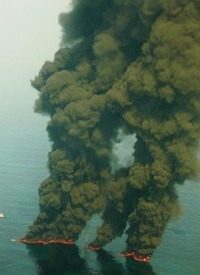
But while at the top the giant oil company might claim a dedication to safety, as the investigation into the disaster in the Gulf of Mexico continues, it is beginning to appear that the company had severe problems with corporate culture and that money, not safety, was often the most important consideration driving operations.
According to The New York Times, just weeks before the explosion that killed 11 workers on the Deepwater Horizon rig, a survey commissioned by Transocean, the rig’s operator, found that workers there had identified problems with the rig. Another separate report focused on the rig’s "safety culture." Said the Times: "Together, these new reports paint a detailed picture of Transocean’s upkeep of the rig, decision making and its personnel."
The reports noted, according to the Times, that workers were concerned about poor equipment reliability, "which they believed was as a result of drilling priorities taking precedence over planned maintenance." One worker pointed out the company’s policy of pushing equipment to the breaking point. "Run it, break it, fix it. That’s how they work," the employee reportedly said.
In addition to unveiling the hard-charging philosophy behind rig operations on the Deepwater Horizon, the reports also are drawing a picture of a crew on the rig working in a climate of fear marked by distrust of corporate officials onshore.
According to the report, "Almost everyone felt they could raise safety concerns and these issues would be acted upon if this was within the immediate control of the rig." But, once an issue got beyond the rig crew itself, a breakdown in trust was obvious.
"It must be stated at this point, however, that the workforce felt that this level of influence was restricted to issues that could be resolved directly on the rig, and that they had little influence at Divisional or Corporate levels," investigators wrote. Emphasizing the break between onsite personnel and those in management, the report continues: "This fear was seen to be driven by decisions made in Houston, rather than those made by rig based leaders."
Those on the rig, the reports claim, worked in constant fear for their jobs. "I’m petrified of dropping anything from heights not because I’m afraid of hurting anyone (the area is barriered off), but because I’m afraid of getting fired," said one employee. Another said: "The company is always using fear tactics. All these games and your mind gets tired."
Employees working under such conditions are likely to take actions that they think will protect their jobs, at the expense of taking actions properly in an open environment, and this is just what happened on the rig. According to the reports, workers on the rig almost unanimously felt that Transocean’s health and safety reporting system was "counter productive."
Consequently, "Many workers entered fake data to try to circumvent the system," the Times reported. "As a result, the company’s perception of safety on the rig was distorted, the report concluded."
Both the disconnect between corporate officials and workers on the rig and the propensity to put monetary considerations before safety seem likely to have played a role in the onset of the disaster.
On the morning of the explosion, BP and Transocean officials argued over how to operate the well. According to CNN, "The BP official wanted workers to replace heavy mud, used to keep the well’s pressure down, with lighter seawater to help speed a process that was costing an estimated $750,000 a day and was already running five weeks late."
A Transocean official objected, but BP won the argument. "He basically said, ‘Well, this is how it’s gonna be’," recalled rig survivor Doug Brown.
After that, Dewey Ravette, the chief driller, "expressed concern" about the decision. Rig survivor Daniel Barron III told CNN, "Dewey was reluctant to try to do it because he didn’t feel it was the right way to have things done." Dewey Revette was one of those who died in the explosion.
In fact, problems with the blow-out preventer on the rig were raised months in advance by BP employee Ronald Sepulvado, who had been in charge of the rig until April 16. In testimony he said that he told his supervisors months before the accident that there was a problem with the blowout preventer.
Federal regulations state that drilling in federal waters must stop if "a BOP control station or pod that does not function properly" is found. Said Sepulvado: "I assumed everything was OK because I reported it to the team leader, and he should have reported it to MMS [Minerals Management Service]."
Warnings about potential problems also came from Halliburton, a firm engaged in some operations on the rig. Two days before the explosion, Halliburton warned BP that its design for the well could cause a "severe gas flow problem."
According to the New Orleans Times-Picayune, "BP opted to push ahead anyway. Halliburton previously had urged BP to install additional equipment that would have made the well more stable. Previously disclosed e-mail messages from BP officials showed that the company rejected Halliburton’s suggestion because BP’s final design ‘saves a good deal of time/money.’"
Related Stories:


